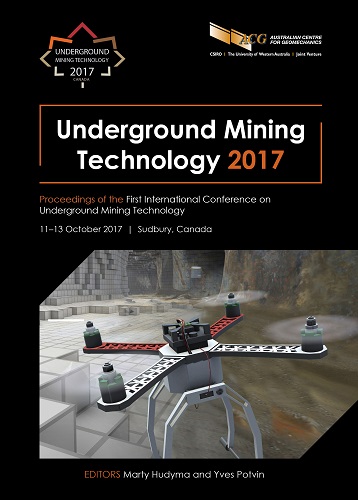Rapid selection strategies for tunnel development auxiliary ventilation systems

|
Authors: San Martin, YH; Hurtado, JP; Vargas, JP; Acuña, EI |
DOI https://doi.org/10.36487/ACG_rep/1710_14_Hurtado
Cite As:
San Martin, YH, Hurtado, JP, Vargas, JP & Acuña, EI 2017, 'Rapid selection strategies for tunnel development auxiliary ventilation systems', in M Hudyma & Y Potvin (eds), UMT 2017: Proceedings of the First International Conference on Underground Mining Technology, Australian Centre for Geomechanics, Perth, pp. 177-187, https://doi.org/10.36487/ACG_rep/1710_14_Hurtado
Abstract:
Auxiliary ventilation system selection in tunnel development projects can be challenging depending on different site limitations, such as opening size and length, available power, environmental conditions, expected fleet, advance rates and equipment dimensions. This paper presents the technical and economic analysis study developed for various alternatives of auxiliary ventilation systems to support the development of mining tunnels. The represented variables are the different components of ventilation systems and five different tunnel drift cross-sections. The auxiliary ventilation system configurations considered in this study are in accordance with the legislated Chilean requirements, which are similar to Canadian regulations with regards to mining development. The methodology proposed in this paper consists of elaborate pre-calculated scenarios that allow a faster approach to the design of auxiliary ventilation systems in horizontal developments considering reduced cost of investment (CAPEX) and operations (OPEX) while complying with local regulations. The methodology used consisted of collecting the information available from the mine sites, and then a set of case studies for the calculations of the various parameters of the auxiliary ventilation systems. Technical and economic ranges are then estimated to select the ducting size, material roughness (friction or k factor) and geometrical parameters for the design of the mining tunnel auxiliary systems. This strategy provided ease and speed in the calculation and analysis of the costs associated with auxiliary ventilation systems, allowing for a faster convergence to a good solution when selecting a ventilation system for mining tunnel development.
Keywords: auxiliary mine ventilation systems, rapid selection methodology, tunnel development
References:
Benedict, R 1980, Fundamentals of Pipe Flow, John Wiley & Sons, New York.
De Souza, E 2009, A Practical Guide to Mine Ventilation Design and Control, Queen's University, Kingston.
Hargreaves, D & Lowndes, I 2006, The Computational Modelling of the Ventilation Flows Within a Rapid Development Drivage, University of Nottingham, Nottingham.
Hartman, H 1982, Mine Ventilation and Air Conditioning, John Wiley & Sons, New York.
Idelchik, A 1989, ASHRAE Handbook: Fundamentals, American Society of Heating, Refrigerating and Air-Conditioning Engineers, Atlanta.
Martínez, R & Contreras, E 1992, Computational Selection of Auxiliary Ventilation Equipment, Universidad de Santiago de Chile, Santiago.
McPherson, MJ 2009, Subsurface Ventilation Engineering, University of Nottingham, Nottingham.
Miller, D 1984, Internal Flow Systems, BHRA Fluid Engineering, Cranfield.
Navarro, C & Vargas, J 2012, Simulation of Underground Construction Cycles Using the Montecarlo Method Minera San Pedro Olivo Project, Universidad de Santiago de Chile, Santiago.
San Martín, Y 2016, Development of a Methodology for the Selection of Auxiliary Ventilation Systems in Tunnels for Mining Fairs, Universidad de Santiago de Chile, Santiago.
Toraño, J, Torno, S, Menendez, M, Gent, M & Velasco, J 2009, ‘Models of methane behaviour in auxiliary ventilation of underground coal mining’, International Journal of Coal Geology, vol. 80, no. 1, pp. 35–43.
Vutukuri, VS 1984, ‘Design of Auxiliary Ventilation Systems for Long Drivages’, Proceedings of the Fifth Australian Tunnelling Conference: State of the Art in Underground Development and Construction, Institution of Engineers, Barton.
© Copyright 2025, Australian Centre for Geomechanics (ACG), The University of Western Australia. All rights reserved.
View copyright/legal information
Please direct any queries or error reports to repository-acg@uwa.edu.au
View copyright/legal information
Please direct any queries or error reports to repository-acg@uwa.edu.au